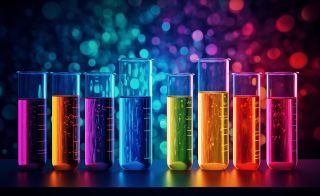Artificial Intelligence
AI System Uses GPT-4 to Learn Nobel Prize-Winning Chemistry
New AI large language model system uses GPT-4 to accelerate chemistry research.
Posted January 4, 2024 Reviewed by Gary Drevitch

We live in transformative times at the intersection of artificial intelligence (AI) language models (LLMs) and complex science. A new study shows how an AI system called Coscientist uses GPT-4, a large language model, to learn and apply Nobel Prize-winning chemistry as well as design, plan, and execute laboratory experiments.
The study was led by Gabe Gomes, an assistant professor at Carnegie Mellon University, and was co-authored by Ben Kline, Robert MacKnight, and Daniil Boiko. Gomes is recognized as a rising star in chemistry and in 2022 was named to Chemical & Engineering News’ “Talented 12.”
Long before chemistry became a formal scientific field of study, humans throughout the ages applied chemical processes such as making ochre paint for cave art, brewing beer, fermenting wine, soap making, glass making, and metallurgy, the extracting of metals from ores.
Modern chemistry, the study of matter and its interactions and reactions to energy and environments, traces back to the initial quantitative experiments of metallurgy performed in a systematic manner. The origins of word chemistry can be traced to the word alchemy from “alchimsta” in Latin, “al-kimiya” in Arabic, and “chemeia” in Greek, according to the Merriam-Webster Dictionary. Early innovators of modern chemistry include 17th-century Anglo-Irish intellectual, natural philosopher, and theologian Robert Boyle (1627-1691), who authored The Sceptical Chymist in 1661, and French chemist and nobleman Antoine-Laurent de Lavoisier (1743-1794) who wrote Elements of Chemistry in 1787.
Starting from ancient times when early humans first discovered how to control fire to cook food and stay warm, to the present day, chemistry has helped improve living standards. Today, chemistry is interwoven in many aspects of modern living. It is the science behind pharmaceutical drugs, personal care and hygiene products, food production, manufacturing, fuel production, laundry products, packaging, clothing, and much more.
For the current study, the researchers explored the efficacy and autonomous capabilities of AI large language models in chemistry research. “Our system demonstrates advanced reasoning and experimental design capabilities, addressing complex scientific problems and generating high-quality code,” they wrote.
They named their AI system Coscientist and tasked it to plan chemical syntheses of known compounds, search and analyze hardware documentation, execute commands in a cloud laboratory using documentation, control liquid handling instruments, manage complex systems of hardware modules and datasets from a variety of sources, and solve optimization problems by analyzing experimental data from prior experiments.
Users can prompt Coscientist in everyday language. Coscientist consists of a GPT-4 Planner that calls on various modules such as web search via a Google Search API, code execution using Python, hardware documentation search, and experiment automation (Cloud laboratory, liquid handler, manual experimentation).
Each component module was evaluated as a standalone before assessing the overall system in unison. The researchers evaluated the Web Searcher module on a variety of large language models. For aspirin, acetaminophen, nitroaniline, and phenolphthalein, the Web Searcher module powered by GPT-4 achieved high scores and improved on synthesis planning compared to GPT-3.5, Claude 1.3 by Anthropic, and Falcon-40B-Instruct by Technology Innovation Institute (TII). Their AI system’s ability to learn from documentation was evaluated. To evaluate its coding aptitude, Coscientist was tasked to produce code to control robotic scientific instruments.
After the independent testing of the component modules, the researchers put all the modules of Coscientist up to the daunting task of designing and executing a protocol for Suzuki–Miyaura and Sonogashira cross-coupling reactions.
Synthetic organic chemistry, also called organic synthesis, is the construction of organic molecules in which the main element is carbon. The Suzuki–Miyaura coupling, also known as the Suzuki coupling, and Sonogashira are methods of constructing carbon-to-carbon bonds using palladium as a catalyst. Examples of organic synthesis include the synthesis of urea for fertilizer for farming and agriculture, polyethylene for packaging, and polyester and nylon for the textile industry.
In 2010, Akira Suzuki, Richard Heck, and Ei-ichi Negishi won the Nobel Prize in Chemistry for the development of a chemical tool called palladium-catalyzed cross-coupling that enables the creation of complex carbon-based molecules. Thus, in effect, Coscientist was tasked by the research team with designing protocols for chemistry that garnered the Nobel Prize.
With the creation of Coscientist, the team had demonstrated proof-of-concept that an AI large language model system can effectively help automate scientific chemistry research with tremendous potential upside for humanity.
In a dual-use analysis of Coscientist, the scientists recommend to all major players in the AI community to prioritize safety to ensure ethical and responsible use of AI large language models and call upon the physical sciences community to engage with LLM developers to help develop guardrails. At a minimum, the researchers recommend incorporating human specialists to manage and oversee AI activity, using AI machine learning to screen out potentially dangerous novel compounds prior to their introduction into the AI system, maintaining data quality and reliability with ongoing curating and updating of data sources, and deploying overall system security measures such as encryption and access controls.
“The development of more integrated scientific tools for LLMs has potential to greatly accelerate new discoveries,” the scientists concluded.
According to the researchers, Coscientist may speed up scientific research, democratize scientific resources by making experimentation more accessible, enable interdisciplinary collaborations, help educate and train, and reduce research and development costs.
Copyright © 2024 Cami Rosso All rights reserved.




